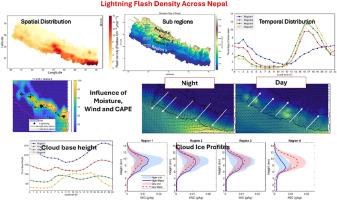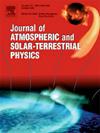Spatio-temporal variations of lightning activity over Nepal's complex terrain: Links to altitude and meteorological factors
IF 1.9
4区 地球科学
Q3 GEOCHEMISTRY & GEOPHYSICS
Journal of Atmospheric and Solar-Terrestrial Physics
Pub Date : 2025-08-27
DOI:10.1016/j.jastp.2025.106615
引用次数: 0
Abstract
This study investigates the diurnal and seasonal variations of lightning activity over the complex terrain of Nepal, which spans elevations from 59 m to 8848 m above sea level. Despite lightning being a leading weather-related hazard in Nepal, causing over 100 fatalities annually, the altitudinal distribution of lightning has received limited attention. We use lightning data from the GLD360 network and meteorological parameters from the ERA5 reanalysis to analyze the influence of Convective Available Potential Energy (CAPE), wind, temperature, humidity, and cloud structure on lightning activity. Results reveal a strong altitudinal gradient in lightning flash density (FD), with maxima in the southern foothills and significant decrease toward higher elevations. Temporally, lightning exhibits two prominent peaks: one in the afternoon and the other around midnight. Afternoon lightning in the higher elevations is associated with surface heating, upslope winds, increased CAPE and moisture convergence, whereas nocturnal lightning over foothills is linked to persistent CAPE and downslope (katabatic) wind convergence. Cloud base height (CBH) further supports this spatial and temporal convection shift. Correlation analyses show strong FD–CAPE–humidity relationships in the foothills that weaken with elevation, suggesting increasing influence of orographic and microphysical processes aloft. The ratio of negative to positive CG flashes increases with elevation, likely influenced by CBH. Vertical profiles of ice water content and vertical velocity reinforce a clear transition from nocturnal convection in the southern plains to thermally and topographically driven daytime convection in the northern mountains. This study highlights how terrain modulates convective regimes and lightning variability across Nepal.

尼泊尔复杂地形上闪电活动的时空变化:与海拔和气象因素的联系
本研究研究了尼泊尔复杂地形上闪电活动的日变化和季节变化,该地形跨越海拔59米至8848米。尽管闪电是尼泊尔主要的与天气有关的灾害,每年造成100多人死亡,但闪电的海拔分布受到的关注有限。利用GLD360网络的闪电资料和ERA5再分析的气象参数,分析对流有效势能(CAPE)、风、温度、湿度和云结构对闪电活动的影响。结果表明,闪电密度(FD)具有较强的海拔梯度,在南部丘陵地区最大,向高海拔方向显著降低。从时间上看,闪电呈现出两个突出的高峰:一个在下午,另一个在午夜左右。高海拔地区的下午闪电与地面加热、上坡风、CAPE增加和水汽辐合有关,而丘陵地区的夜间闪电与持续的CAPE和下坡(倾斜)风辐合有关。云底高度(CBH)进一步支持这种时空对流转移。相关分析显示,山麓的fd - cape -湿度关系随着海拔的升高而减弱,这表明高空地形和微物理过程的影响越来越大。负CG与正CG的比值随海拔升高而增加,可能受CBH的影响。冰水含量和垂直速度的垂直剖面加强了从南部平原夜间对流到北部山区热力和地形驱动的日间对流的明显转变。这项研究强调了地形如何调节尼泊尔的对流状态和闪电变化。
本文章由计算机程序翻译,如有差异,请以英文原文为准。
求助全文
约1分钟内获得全文
求助全文
来源期刊

Journal of Atmospheric and Solar-Terrestrial Physics
地学-地球化学与地球物理
CiteScore
4.10
自引率
5.30%
发文量
95
审稿时长
6 months
期刊介绍:
The Journal of Atmospheric and Solar-Terrestrial Physics (JASTP) is an international journal concerned with the inter-disciplinary science of the Earth''s atmospheric and space environment, especially the highly varied and highly variable physical phenomena that occur in this natural laboratory and the processes that couple them.
The journal covers the physical processes operating in the troposphere, stratosphere, mesosphere, thermosphere, ionosphere, magnetosphere, the Sun, interplanetary medium, and heliosphere. Phenomena occurring in other "spheres", solar influences on climate, and supporting laboratory measurements are also considered. The journal deals especially with the coupling between the different regions.
Solar flares, coronal mass ejections, and other energetic events on the Sun create interesting and important perturbations in the near-Earth space environment. The physics of such "space weather" is central to the Journal of Atmospheric and Solar-Terrestrial Physics and the journal welcomes papers that lead in the direction of a predictive understanding of the coupled system. Regarding the upper atmosphere, the subjects of aeronomy, geomagnetism and geoelectricity, auroral phenomena, radio wave propagation, and plasma instabilities, are examples within the broad field of solar-terrestrial physics which emphasise the energy exchange between the solar wind, the magnetospheric and ionospheric plasmas, and the neutral gas. In the lower atmosphere, topics covered range from mesoscale to global scale dynamics, to atmospheric electricity, lightning and its effects, and to anthropogenic changes.
 求助内容:
求助内容: 应助结果提醒方式:
应助结果提醒方式:


